SRM-AP All News
ALL News
- Successful Food-Tech Venture hoists Jaswanth to Newer Heights! December 19, 2022
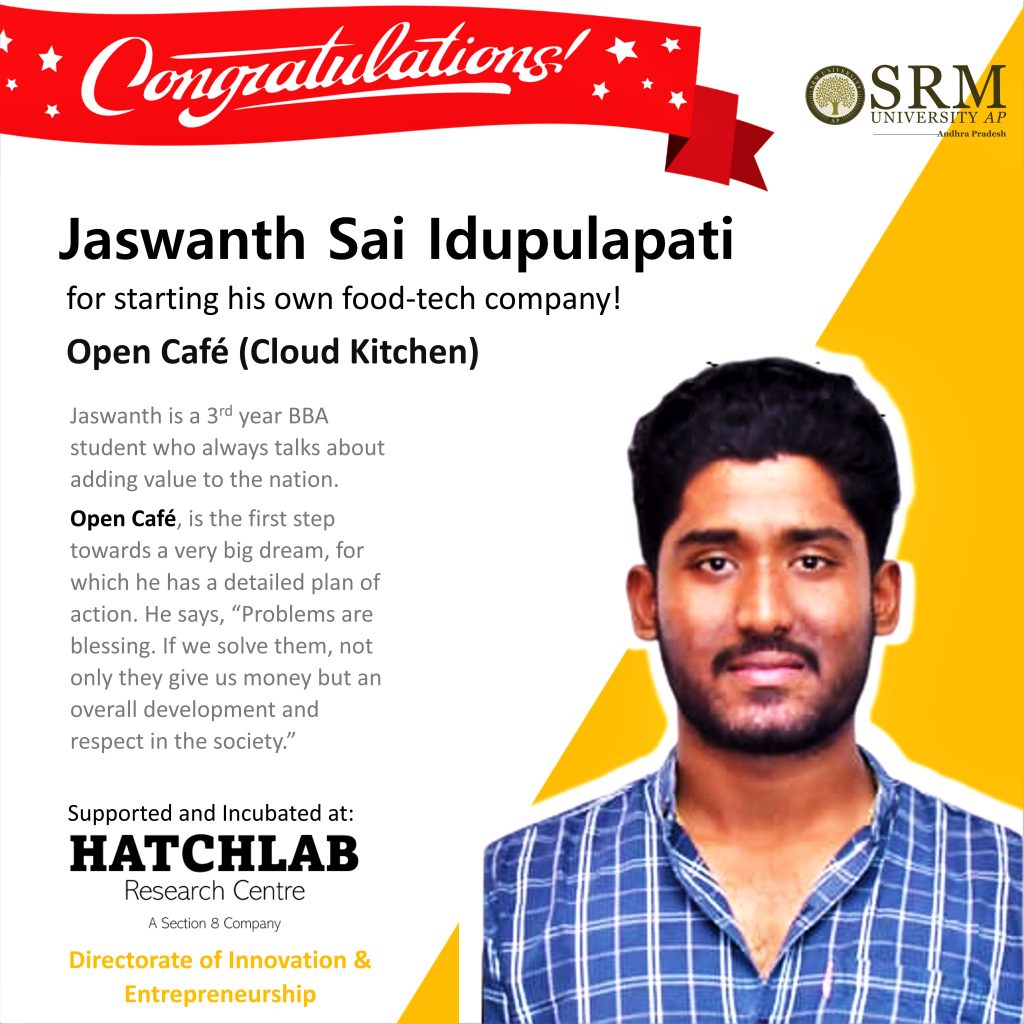
“The best way to predict the future is to create it”. Jaswanth Sai has proved to be a living and breathing manifestation of this quote with his determination and hard work. The Directorate of Entrepreneurship and Innovation is pleased to announce that Jaswanth Sai Idupulapati, a 3rd year BBA student, has successfully started his own food-tech company, Open Cafe, a cloud kitchen enterprise. Cloud kitchens are centralised, licensed commercial food production facilities where one to dozens of restaurants rent space to prepare delivery-optimised menu items. Jaswanth, an enthusiastic student of the Hatchlab Research Centre had started his business with an investment of Rs. 5000/- and today his turnover is more than 20L per month for a business that was started just three months ago!
“We invested Rs. 5000 and brought a van full of biriyani outside the main gate of our university. Hours passed and not a single sale happened. Those moments were not only depressing but also terribly demotivating. But as a leader, I had to rise up! We immediately changed the pricing strategy and shared the same via WhatsApp groups. In the next 45 minutes, we were left with empty vessels and a handful of cash. Profit was less; the learning and our confidence levels were mountain high,” Jaswanth excitedly mentioned about his first day of business.
As of now, Open Cafe caters to more than 1000+ students from SRM AP and VITAP, with quality food items that are delivered with a caption – 15 minutes delivery. Jaswanth has 15 employees and a big renovated kitchen, generating employment and thousands of satisfied customers.
His dedication and hardcore willpower allowed the materialisation of his idea into reality. Congratulations to Jaswanth Sai for his astonishing achievement!
Continue reading → - Dr Raviteja KVNS Received the Best Paper Award at TRACE 2022 December 16, 2022
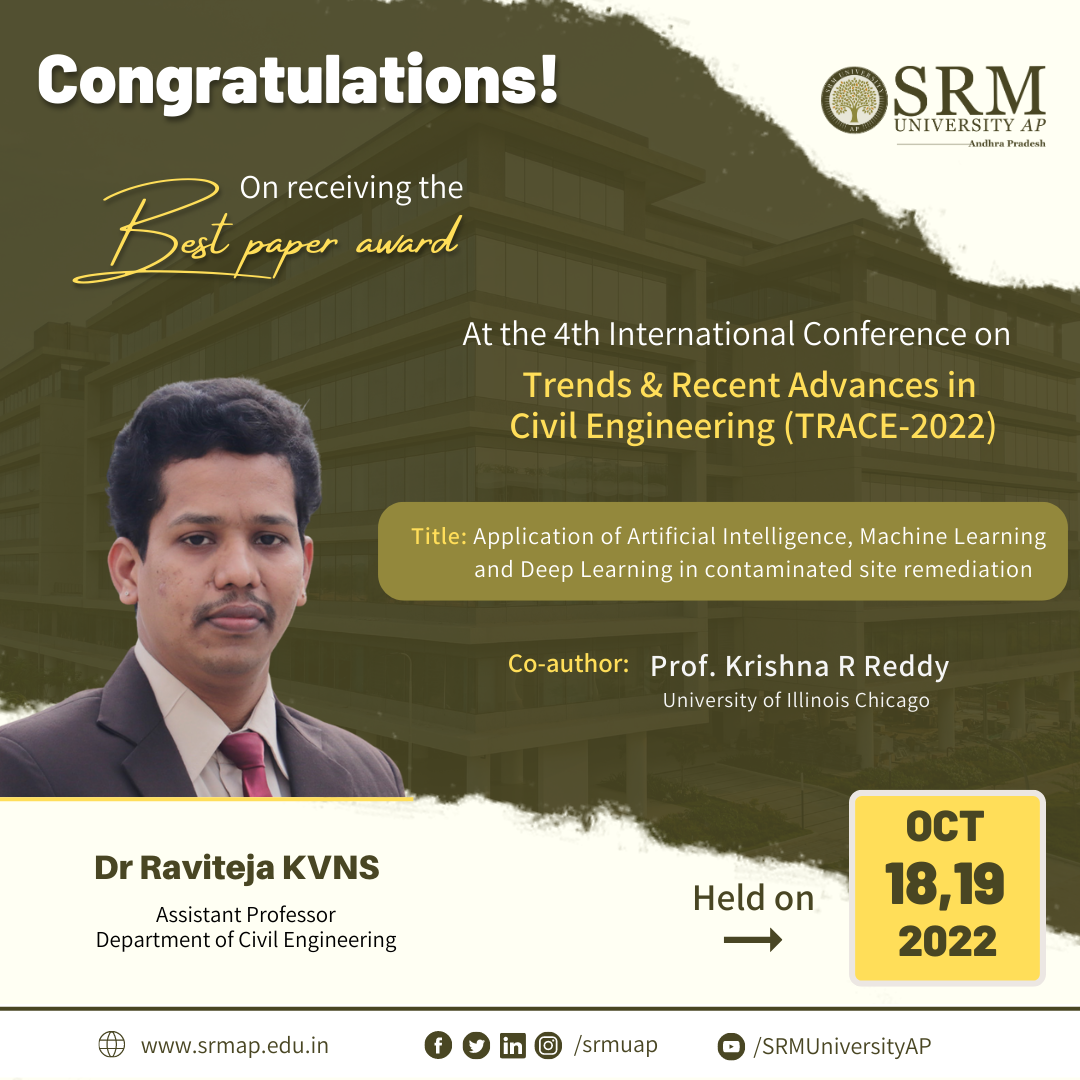 Soil and groundwater contamination is closely interlinked with human society because of its direct impact on population health and socioeconomic activities. The design and implementation of site remediation can be expensive, time-consuming, and may require much human effort. Emerging technologies such as Artificial Intelligence, Machine Learning, and Deep Learning have the potential to make site remediation cost-effective with reduced human effort.
Soil and groundwater contamination is closely interlinked with human society because of its direct impact on population health and socioeconomic activities. The design and implementation of site remediation can be expensive, time-consuming, and may require much human effort. Emerging technologies such as Artificial Intelligence, Machine Learning, and Deep Learning have the potential to make site remediation cost-effective with reduced human effort.Assistant Professor Dr Raviteja KVNS, Department of Civil Engineering, has received the Best Paper Award at the Fourth International Conference on Trends and Recent Advances in Civil Engineering (TRACE) 2022 for his paper Application of artificial intelligence, machine learning and deep learning in contaminated site remediation. The conference was held at Amity University, Uttar Pradesh, on October 18 and 19, 2022. His research reports the applications of AI and ML in contaminated site remediation.
Dr Raviteja’s future research plan includes studying potential applications of various AI, ML and DL techniques for Geotechnical and Geo-environmental design and testing applications so as to reduce the labours of physical and repetitive testing and associated human effort. This further improves precision as well as aids in decision-making. He has collaborated with Prof. Krishna R Reddy, University of Illinois Chicago, for this research work.
Abstract
Soil and groundwater contamination is caused by improper waste disposal practices and accidental spills, posing a threat to public health and the environment. It is imperative to assess and remediate these contaminated sites to protect public health and the environment as well as to assure sustainable development. Site remediation is inherently complex due to the many variables involved, such as contamination chemistry, fate and transport, geology, and hydrogeology. The selection of remediation method also depends on the contaminant type and distribution and subsurface soil and groundwater conditions. Depending on the type of remediation method, many systems and operating variables can affect the remedial efficiency. The design and implementation of site remediation can be expensive, time-consuming, and may require much human effort. Emerging technologies such as Artificial Intelligence, Machine Learning, and Deep Learning have the potential to make site remediation cost-effective with reduced human effort. This study provides a brief overview of these emerging technologies and presents case studies demonstrating how these technologies can help contaminated site remediation decisions.
- EEE Students Visited Dr Narla Thatharao Thermal Power Station (NTTPS) December 16, 2022
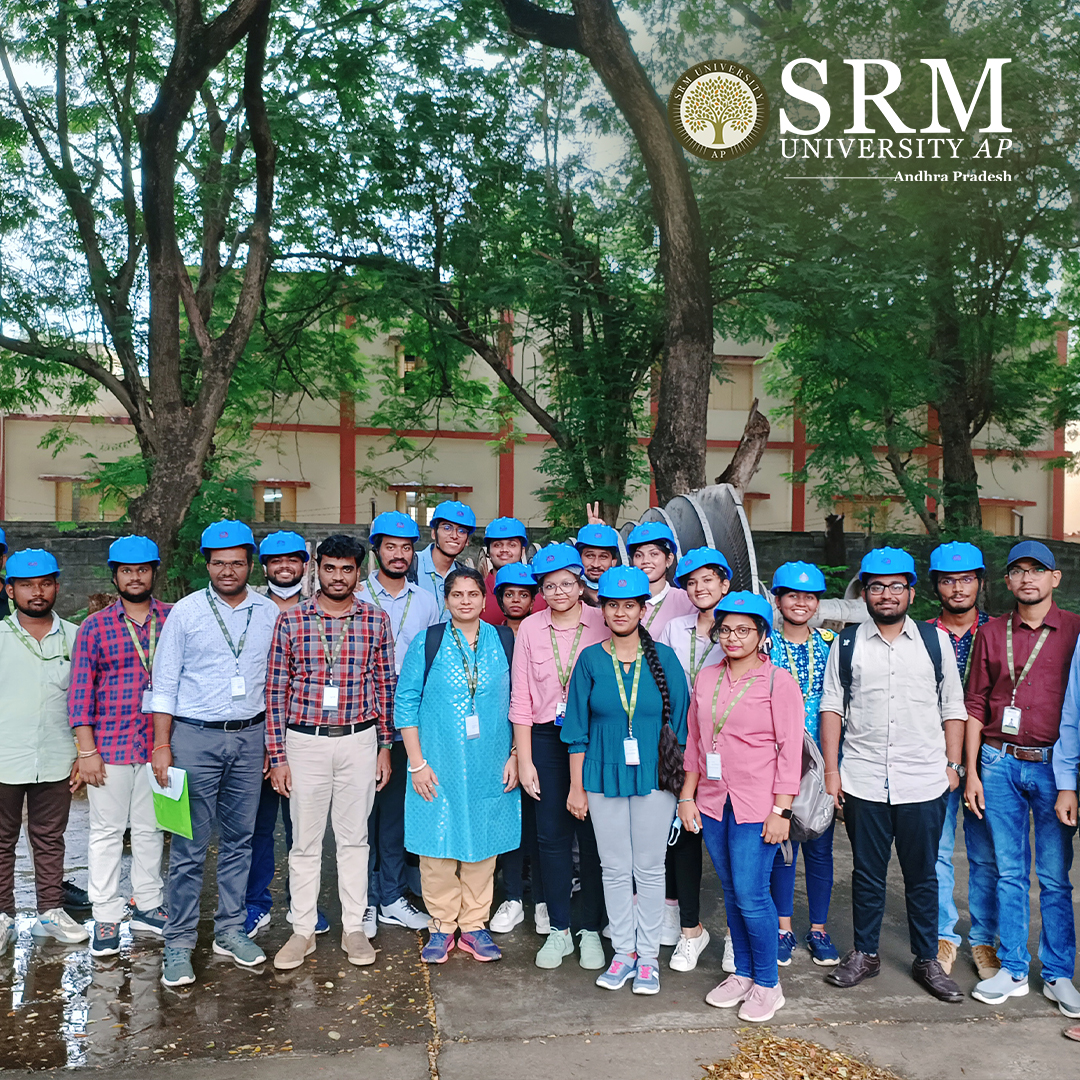 Industrial visit is an efficient learning strategy that nullifies the distance between academia and industry. Students and faculty of the Department of Electrical and Electronics Engineering visited Dr Narla Thatharao Thermal Power Station (NTTPS) on November 21, 2022. The objective of the visit was to give an overview of the Thermal Power plant, which is a coal-based power plant where coal is transported from coal mines to the power plant by railway in wagons or a merry-go-round system.
Industrial visit is an efficient learning strategy that nullifies the distance between academia and industry. Students and faculty of the Department of Electrical and Electronics Engineering visited Dr Narla Thatharao Thermal Power Station (NTTPS) on November 21, 2022. The objective of the visit was to give an overview of the Thermal Power plant, which is a coal-based power plant where coal is transported from coal mines to the power plant by railway in wagons or a merry-go-round system.The state-of-the-art construction and technologies amazed the students as they experienced an insightful industrial visit that exposed them to the actual working of a thermal power plant while enforcing their theoretical knowledge of Power Systems, Control Systems and Electrical Machines. Students from semesters one to four participated in the industry visit. Dr Somesh Vinayak Tewari, Dr Shubh Lakshmi, Dr Bhamidi Lokeshgupta, Dr Ramanjaneya Reddy U, and Dr Venkata Ramireddy Y were the faculty who accompanied the students.
A Detailed Account of the Industry Visit
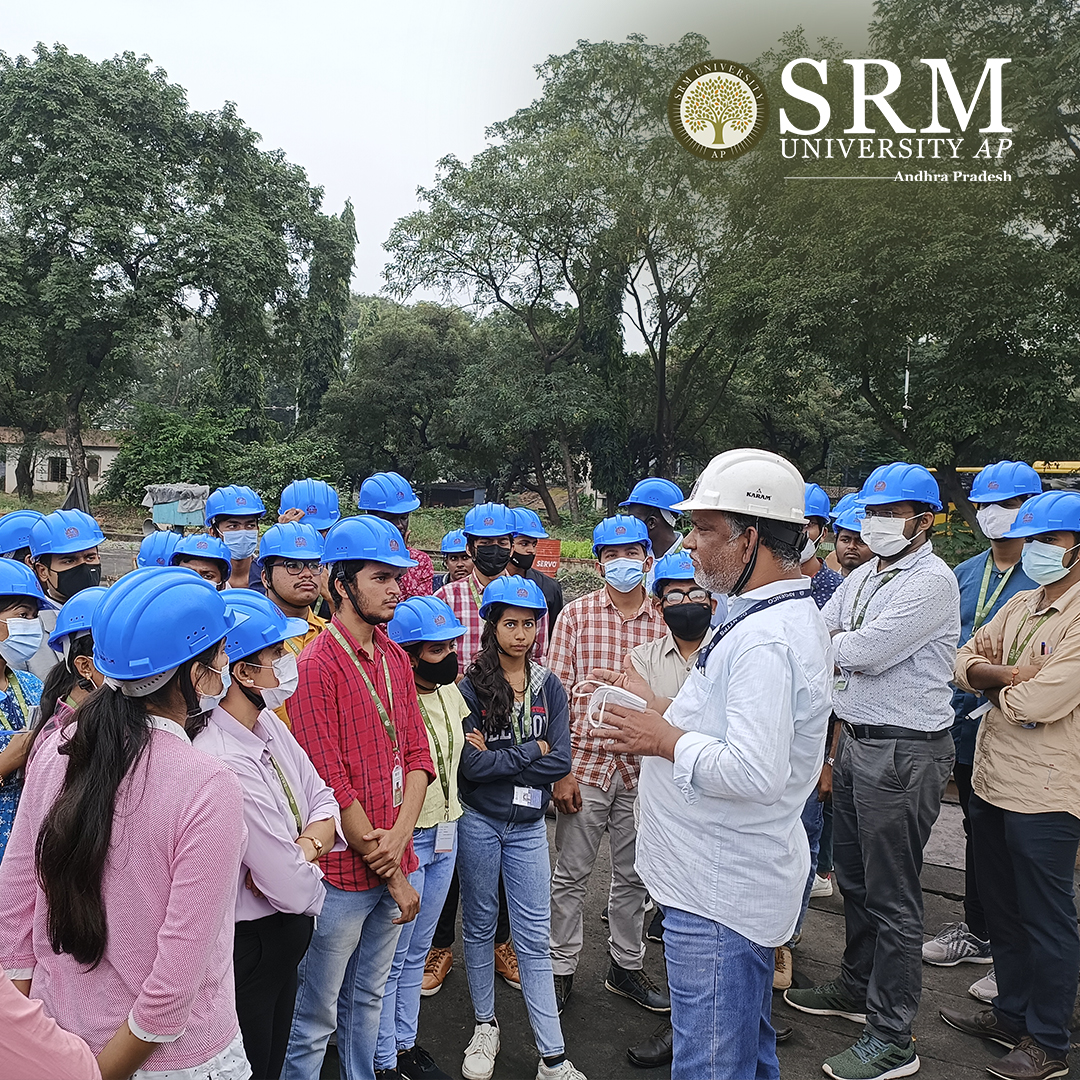 Coal is unloaded from the wagons using wagon tippler units to a moving underground conveyor belt. This coal from the mines is of no uniform size. So, it is taken to the Crusher house and crushed to a size of 20 mm. From the crusher house, the coal is either stored in dead storage, which serves as coal supply in case of coal supply bottleneck or to live storage in the raw coal bunker in the boiler house. Raw coal from the raw coal bunker is supplied to the Coal Mills by a Raw Coal Feeder. The Coal Mills or pulverizer pulverizes the coal. The powdered coal from the coal mills is carried to the boiler in coal pipes by high-pressure hot air. The pulverized coal air mixture is burnt in the boiler in the combustion zone.
Coal is unloaded from the wagons using wagon tippler units to a moving underground conveyor belt. This coal from the mines is of no uniform size. So, it is taken to the Crusher house and crushed to a size of 20 mm. From the crusher house, the coal is either stored in dead storage, which serves as coal supply in case of coal supply bottleneck or to live storage in the raw coal bunker in the boiler house. Raw coal from the raw coal bunker is supplied to the Coal Mills by a Raw Coal Feeder. The Coal Mills or pulverizer pulverizes the coal. The powdered coal from the coal mills is carried to the boiler in coal pipes by high-pressure hot air. The pulverized coal air mixture is burnt in the boiler in the combustion zone.Generally, in modern boilers, a tangential firing system is used where the coal nozzles/guns form a tangent to a circle. The temperature in the fireball is of the order of 1300˚C. The boiler is a water tube boiler hanging from the top. Water is converted to steam in the boiler, and steam is separated from water in the boiler Drum. The saturated steam from the boiler drum is taken to the Low-Temperature Superheater, Platen Superheater and Final Superheater, respectively, for superheating. The superheated steam from the final superheater is taken to the High-Pressure Steam Turbine (HPT). In the HPT, the steam pressure is utilised to rotate the turbine, and the resultant is rotational energy. From the HPT, the outcoming steam is taken to the Reheater in the boiler to increase its temperature as the steam becomes wet at the HPT outlet. After reheating, this steam is taken to the Intermediate Pressure Turbine (IPT) and then to the Low-Pressure Turbine (LPT). The outlet of the LPT is sent to the condenser for condensing back to water by a cooling water system. This condensed water is collected in the Hot well and sent to the boiler in a closed cycle. The rotational energy imparted to the turbine by high-pressure steam is converted to electrical energy in the Generator.
Continue reading → - Aloha 2022: The magnificent fresher’s day celebration at SRM AP December 15, 2022
 Senior students of SRM University-AP received the newcomers with a grand welcome party on November 25 and 26, 2022. The two-day-long celebrations were immaculate and encapsulated the radiant aura of the new-age university.
Senior students of SRM University-AP received the newcomers with a grand welcome party on November 25 and 26, 2022. The two-day-long celebrations were immaculate and encapsulated the radiant aura of the new-age university.Enthralling games, incredible performances, mouth-watering food stalls, booming music, and the brightest grins precisely describe Aloha 2022, the fresher’s day celebrations. Newcomers were welcomed to the festivity of SRM AP with the warmest colours and loudest cheers!
Honourable Vice Chancellor of SRM University- AP, Prof Manoj K Arora, inaugurated the event and asked the students to fully revel in the celebrations. All the faculty, staff and leadership members were also present at the festive occasion to welcome the brand-new batch of students to the campus.
A wide array of entertainment programmes was organised as part of the wholesome event. Students took over the stage by dancing to hype songs and singing their hearts out on both days of the event. The highlight of the event’s second day was the Mr&Ms Freshers contest. The vibe of the fresher’s party reached its peak with the vibrant DJ party filled with loud cheers and solid beats.
Cubing context, Tug of war, crossword, pop culture quiz, bucket game, water race, and many other fun games were also arranged beside the on-stage performances, which kept the students engaged on the two days of the celebrations. The food festival featuring mouth-watering street foods added flavour to the already colourful festival.
Continue reading → - Dr Anil K Suresh and team exploring novel domains of research at SRM AP! December 7, 2022
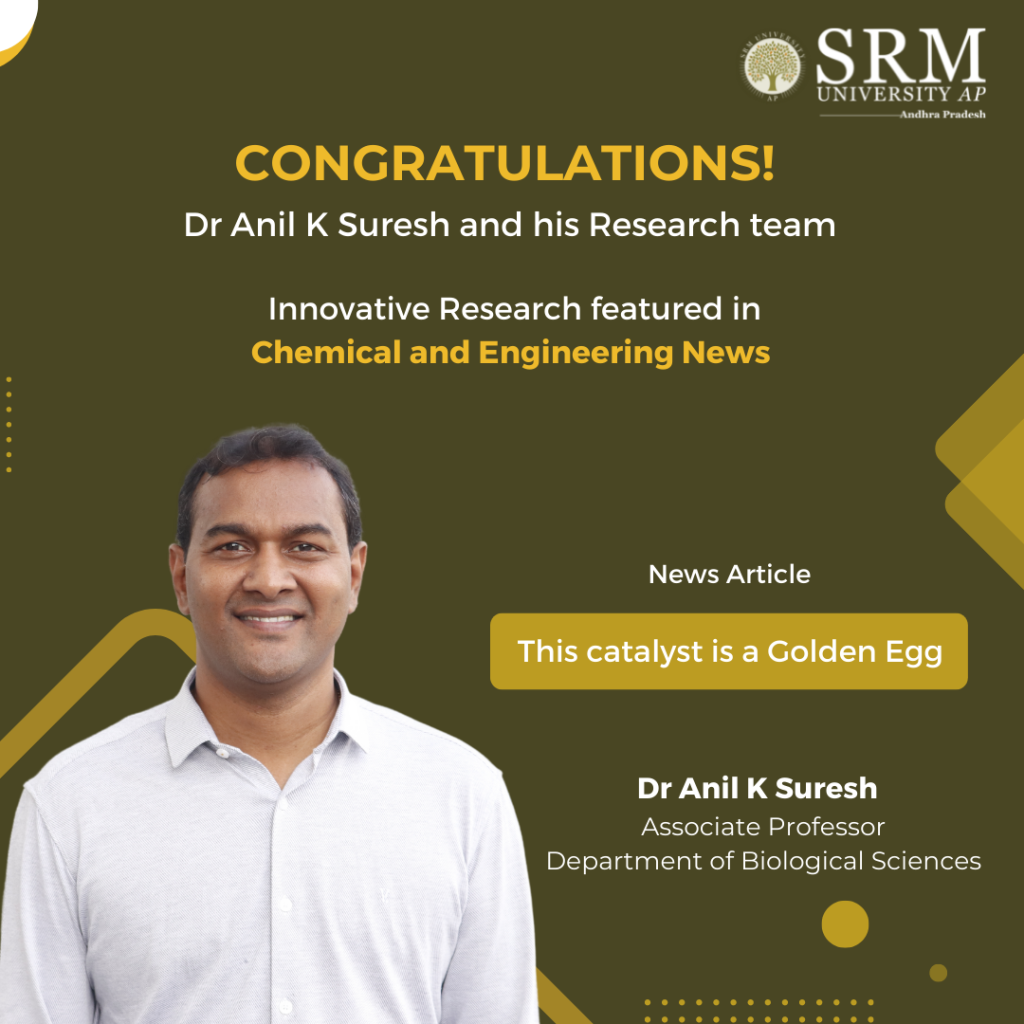
SRM AP proudly congratulates Dr Anil K Suresh, Associate Professor, Department of Biological Sciences and his cohort of research scholars for their rare achievement of having their paper featured in the prestigious weekly news magazine Chemical and Engineering News (ACS-C&EN). The news article titled “This catalyst is a Golden Egg“, edited by Prachi Patel highlights the innovative research conducted by Dr Anil K Suresh and his team on developing a low-cost, sustainable catalyst by infusing eggshells with gold nanoparticles that can be reused and eventually recycled.
The research paper titled Sustainable Bio-Engineering of Gold structured Wide-Area Supported Catalyst for Hand-Recyclable Ultra-Efficient Heterogeneous Catalysis (ACS Appl. Mater. Interfaces 2022, DOI: 10.1021/acsami.2c13564) highlights the team’s breakthrough advance in impregnating eggshells with gold nanoparticles to develop a cheap, and reusable ‘mega catalyst’. The research has used the robust “mega catalyst” to detoxify dye waste and run other organic reactions by dropping the eggshell catalyst into reaction solutions.
Dr Suresh and colleagues dipped waste eggshells collected from restaurants in a suspension containing gold chloride for 6 hours. Consequently, the amino acids on the shells reduced the gold ions to form crystalline gold nanoparticles. Dr Suresh attested this method to be one of the simplest syntheses of a supported catalyst that was ever reported. He emphasised that he and his colleagues have also grafted catalytic silver and copper oxide on eggshells and are now working on methods to do this for platinum and palladium.
SRM University-AP manifests pioneering advancement in innovative domains of research in the field of science and technology. The breakthrough research by Dr Anil K Suresh and his research team is of outstanding achievement and incredible addition to the institution’s laurels in the field of translational research.
Continue reading → - Detecting Breast cancer subtypes using an innovatory ensemble of SwinTs December 6, 2022

Breast cancer (BC) is one of the most common types of cancer among women with a high mortality rate. Histopathological analysis facilitates the detection and diagnosis of BC but is a highly time-consuming specialised task, dependent on the experience of the pathologists. Hence, there is a dire need for computer-assisted diagnosis (CAD) to relieve the workload on pathologists. Dr Sudhakar Tummala, Assistant Professor, Department of Electronics and Communication Engineering, has conducted breakthrough research on this domain in his paper titled BreaST-Net: Multi-Class Classification of Breast Cancer from Histopathological Images Using Ensemble of Swin Transformers published in the Q1 Journal Mathematics, having an Impact Factor of 2.6.
Abstract
Breast cancer (BC) is one of the deadly forms of cancer and a major cause of female mortality worldwide. The standard imaging procedures for screening BC involve mammography and ultrasonography. However, these imaging procedures cannot differentiate subtypes of benign and malignant cancers. Therefore, histopathology images could provide better sensitivity toward benign and malignant cancer subtypes. Recently, vision transformers are gaining attention in medical imaging due to their success in various computer vision tasks. Swin transformer (SwinT) is a variant of vision transformer that works on the concept of non-overlapping shifted windows and is a proven method for various vision detection tasks. Hence, in this study, we have investigated the ability of an ensemble of SwinTs for the 2- class classification of benign vs. malignant and 8-class classification of four benign and four malignant subtypes, using an openly available BreaKHis dataset containing 7909 histopathology images acquired at different zoom factors of 40×, 100×, 200× and 400×. The ensemble of SwinTs (including tiny, small, base, and large) demonstrated an average test accuracy of 96.0% for the 8-class and 99.6% for the 2-class classification, outperforming all the previous works. Hence, an ensemble of SwinTs could identify BC subtypes using histopathological images and may lead to pathologist relief.
A brief summary of the research in layperson’s terms
Breast cancer (BC) is the second deadliest cancer after lung cancer, causing morbidity and mortality worldwide in the women population. Its incidence may increase by more than 50% by the year 2030 in the United States. The non-invasive diagnostic procedures for BC involve a physical examination and imaging techniques such as mammography, ultrasonography and magnetic resonance imaging. However, the physical examination may not detect it early, and Imaging procedures offer low sensitivity for a more comprehensive assessment of cancerous regions and identification of cancer subtypes. Histopathological imaging via breast biopsy, even though minimally invasive, may provide accurate identification of the cancer subtype and precise localization of the lesion. However, this manual examination by the pathologist could be tiresome and prone to errors. Therefore, automated methods for BC subtype classification are warranted.
Deep learning has revolutionised many areas in the last decade, including healthcare for various tasks such as accurate disease diagnosis, prognosis, and robotic-assisted surgery. There were studies based on deep convolutional neural networks (CNN) for detecting BC using the aforementioned imaging procedures. However, CNNs exhibit inherent inductive bias and are variant to translation, rotation, and location of the object of interest in the image. Therefore, image augmentation is generally applied while training CNN models, although the data augmentation may not provide expected variations in the training set. Hence, self-attention based deep learning models that are more robust towards the orientation and location of an object of interest in the image are rapidly growing.
SwinTs are an improved version of earlier vision transformer (ViT) architecture and are hierarchical vision transformers using shifted windows that work based on self-attention. For efficient modelling, self-attention within local windows was proposed and computed, and to evenly partition the image, the windows are arranged in a non-overlapping manner. The window-based self-attention has linear complexity and is scalable. However, the modelling power of window-based self-attention is limited because it lacks connections across windows. Therefore, a shifted window partitioning approach that alternates between the partitioning configurations in consecutive Swin transformer blocks was proposed to allow cross-window connections while maintaining the efficient computation of non-overlapping windows. The shifted window scheme in Swin transformers offers increased efficiency by restricting self- attention computation to local windows that are non-overlapping while also facilitating a cross-window connection. Overall, the SwinT network’s performance was superior to that of the standard ViTs.
Therefore, the paper analyses the ability of an ensemble of Swin transformer models (BreaST-Net) for the automated multi-class classification of BC by investigating histopathological images. The work dealt with both benign and malignant subtypes. Further, the benign cancer subtypes include fibroadenoma, tubular adenoma, phyllodes tumour, and adenosis. Whereas the malignant subtypes contain ductal carcinoma, papillary carcinoma, lobular carcinoma, and mucinous carcinoma.
Social implications of the research
Dr Sudhaker Tummala explains that the computer-aided subtyping of breast cancer from histopathology images using an ensemble of fine-tuned SwinT models can be an alternative to manual diagnoses, thereby reducing the burden on clinical pathologists.
Collaborations
- Prof. Seifedine Kadry, Department of Applied Data Science, Noroff University College, Kristiansand, Norway
- Dr Jungeun Kim, Division of Computer Science, Department of Software, Kongju National University, Korea
In the future, Dr Tummala will advance his research to add explainability to the ensemble model predictions and also to develop models that can work on fewer data samples.
Continue reading → - Three international offers in Japan: Placement 2022 hits a new peak December 6, 2022
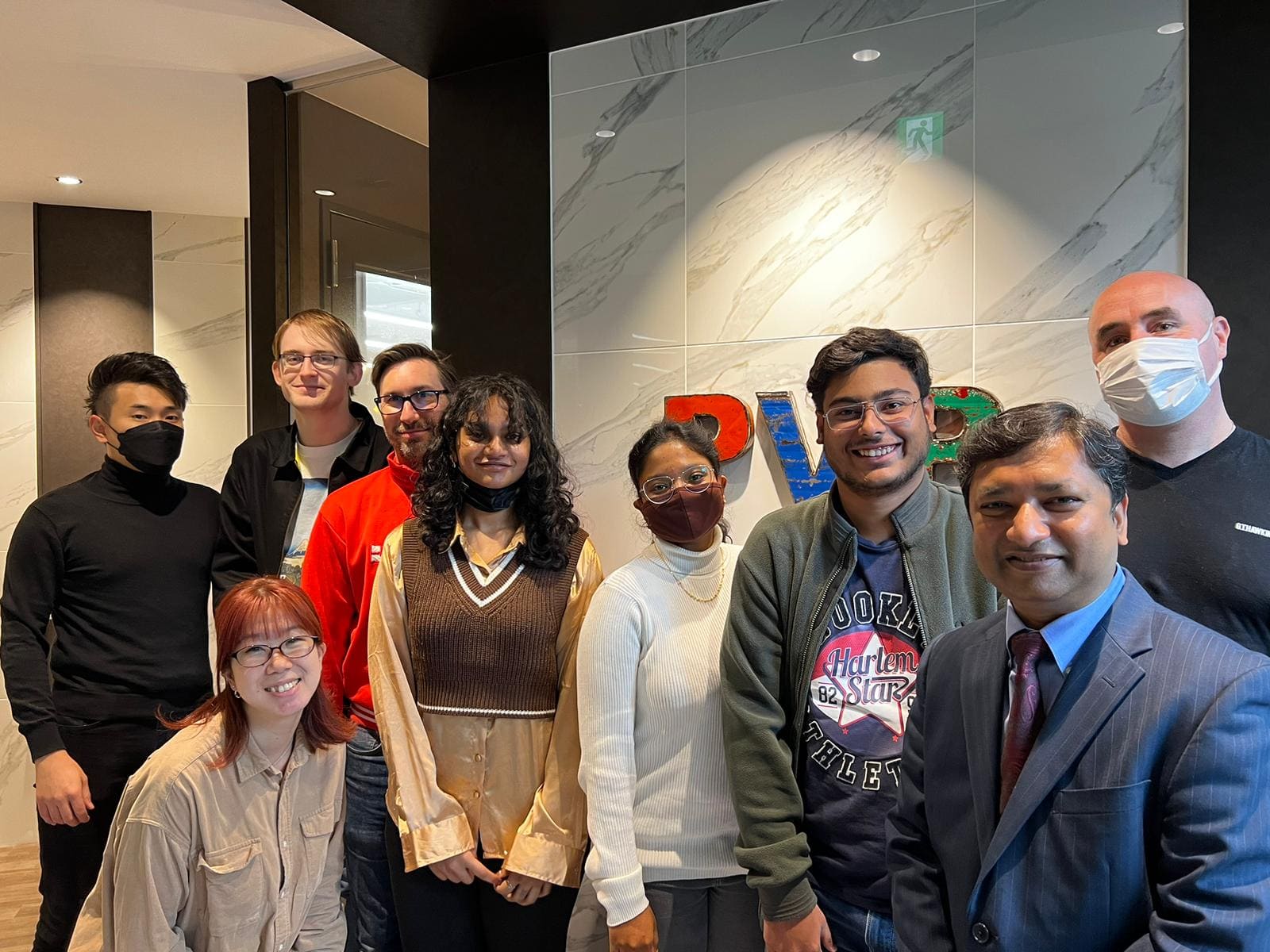 Japan boasts the third-largest economy in the world. Being an incredible destination for aspirants, Japan proffers limitless opportunities and a rewarding career. The International offers in Japan are the brand-new addition to the success saga of placement 2022 at SRM University-AP. Three students from the class of 2022 have been placed with the international firm PVP in Japan with a lucrative salary package of 45 LPA. Alex Martin Mason, Ravi Srihitha, and Sahitha Yalamanchili of the Department of Computer Science and Engineering and Electronics and Communication Engineering are making the institution proud with their academic rigour and industrial skillset.
Japan boasts the third-largest economy in the world. Being an incredible destination for aspirants, Japan proffers limitless opportunities and a rewarding career. The International offers in Japan are the brand-new addition to the success saga of placement 2022 at SRM University-AP. Three students from the class of 2022 have been placed with the international firm PVP in Japan with a lucrative salary package of 45 LPA. Alex Martin Mason, Ravi Srihitha, and Sahitha Yalamanchili of the Department of Computer Science and Engineering and Electronics and Communication Engineering are making the institution proud with their academic rigour and industrial skillset.Japan is well known for its concrete work ethic and fascinating culture. For students to be placed in Japan, more than just technical training, Japanese language proficiency and cultural knowledge are equally important. The Directorate of Corporate Relations and Career Services made sure to equip the students with intensive training in the Japanese language and culture. The international placement is also a commendable achievement for the team working exclusively on Japanese placements.
Continue reading → - Bioinspired GO/Au nanocomposite synthesis November 28, 2022
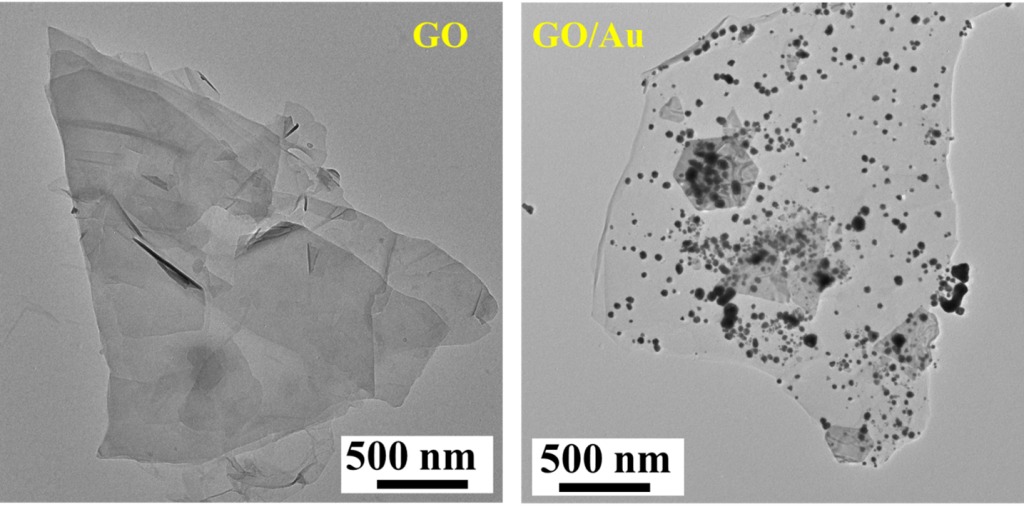
Nanocomposites are the heterogeneous materials that are produced by the mixtures of polymers with inorganic solids that are multi-phased with two or three dimensions of less than 100 nanometers (nm). Nanocomposites offer advanced technologies in enhancing several industrial sectors like automobile, construction, electronics and electrical, food packaging, and technology transfer, yet its sustainable and environment-friendly nature provides a great deal for mankind. Dr Imran Uddin, Post Doctoral fellow, Department of Physics, has published a paper titled “Bioinspired GO/Au nanocomposite synthesis: Characteristics and use as a high-performance dielectric material in nanoelectronics” in the South African Journal of Botany, having an impact factor of 3.11. The paper demonstrated that GO-based materials are better constituents for nanocomposite synthesis and facilitate in enhancing the performance of electrical devices and energy storage systems.
Abstract
A bioinspired method was used to synthesise a graphene oxide (GO) based noble metal (Au) nanocomposite (GO/Au nanocomposite) using chemically exfoliated graphene oxide as the base matrix and gold (Au) nanoparticles. GO’s structural properties and morphology and the GO/Au nanocomposite were determined using XRD, TEM, SEM, EDAX, FTIR, and TGA analysis. LCR analysis was used to characterise the electrical characteristics of GO dielectric features as a function of frequency. The dielectric permittivity and electrical conductivity of GO were very frequency-driven. The results demonstrated that GO has direct current and Correlated Barrier Hopping conductivity processes in the low and high-frequency bands. The dielectric constant of the GO/Au nanocomposite shows that the bioinspired approach includes organic macromolecules capable of modest GO reduction and so modifying the C/O ratio, resulting in an enhancement in the matrix’s dielectric characteristics. This work shows that GO-based materials can be used to scale up high-performance electronic devices, as well as electrical and energy storage systems.
Explanation of the research in layperson’s terms
Energy consumption has increased multifold over the past few years. With increased consumption, the need for energy production and storage has become a pressing priority in the current generation. Dr Imran Uddin’s work aims to propose an idea to synthesise a mixture of two energy-storing materials (gold and carbon) at room temperature. Keeping in view the mentioned aim, he has used plant seeds to create this energy-storing mixture, also known as dielectric material in scientific terms. Through various analyses, he has noticed that this material is able to store electric energy at a lower frequency than the parent material. The superiority of this material comes into play in that when it expires, it can be easily disposed of without creating pollution, which goes hand in hand with the ultimate aim to develop sustainable energy-storing devices.
Dr Imran Uddin has mentioned the practical implication of the groundbreaking research. Capacitors are electronic devices that store electric energy in the form of charges. When a capacitor is linked to a charging circuit, it can store electric energy and release that stored energy when attached to an external circuit (like cars, fans, nuclear weapons, etc.), allowing it to be used as a temporary battery. Moreover, the synthetic GO/Au nanocomposite has the potential to be used as a capacitor material in biomedical applications (defibrillators, blood gas analyzers, pacemakers, biomedicines, etc.), as well as other fields where non-toxicity is essential.
The future prospects of Dr Imran Uddin’s research view an ambitious plan to manufacture more materials at room temperature using the green synthesis root. He also intends to investigate the electrochemical characteristics of environmentally benign materials in the field of electrochemical energy storage, such as supercapacitors and batteries.
Collaborations
University of Pannonia, Hungary
Continue reading → - The war of drones: A workshop on the latest potent technology November 28, 2022
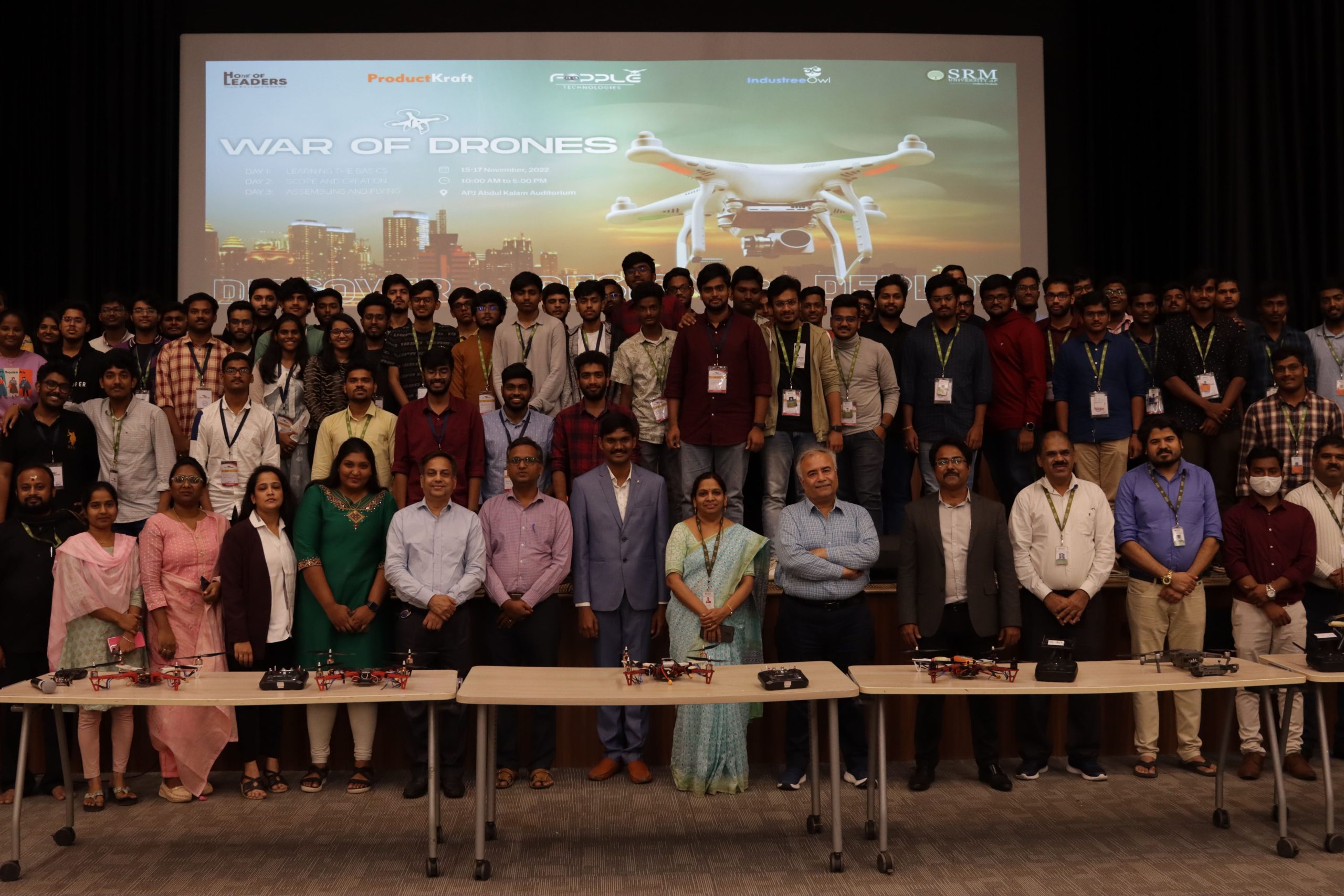 Drones are steadily evolving technology with a wide array of applications in various sectors that, over the next decade, will change in ways that are unimagined. The War of Drones, a workshop on drone technology organised by the Directorate of Entrepreneurship and Innovation, got off the ground on Monday, November 14, 2022. The three-day-long sessions were under the guidance of Sri Gopi Raja, CEO of Fopple Technology Pvt Ltd. Andra Pradesh. The workshop came to an end after the theory, assembling of drones, and the final drone flying sessions that lasted for three days.
Drones are steadily evolving technology with a wide array of applications in various sectors that, over the next decade, will change in ways that are unimagined. The War of Drones, a workshop on drone technology organised by the Directorate of Entrepreneurship and Innovation, got off the ground on Monday, November 14, 2022. The three-day-long sessions were under the guidance of Sri Gopi Raja, CEO of Fopple Technology Pvt Ltd. Andra Pradesh. The workshop came to an end after the theory, assembling of drones, and the final drone flying sessions that lasted for three days.“If someone wants to talk about Drones, they need to talk about Andhra Pradesh,” said Sri Gopi Raja as he addressed the students by highlighting the hand of the state in promoting and modifying the technology nationwide. He highlighted the amplifying relevance of drone technology in the field of agriculture by explaining the various pathbreaking methods and their benefits. He also hinted at the chances for launching a Drones Centre of Excellence at the university.
Honourable Vice Chancellor Prof Manoj K Arora and other dignitaries graced the workshop’s final day with their presence. About 110 students participated in the exciting and engaging workshop to advance their understanding of the latest and promising technology of drones. Students were fascinated by the idea of flying a drone by the end of the workshop. The sessions conferred on the various aspects and applications of drones and allied technologies. The experimental event allowed students to get insights into drone technology from industry experts. They were exposed to hand on assembling and operations of drones. Furthermore, the future and scope of the promising technology were also discussed during the workshop.
Continue reading → - Novel antenna-duplexer for off-body communication November 28, 2022
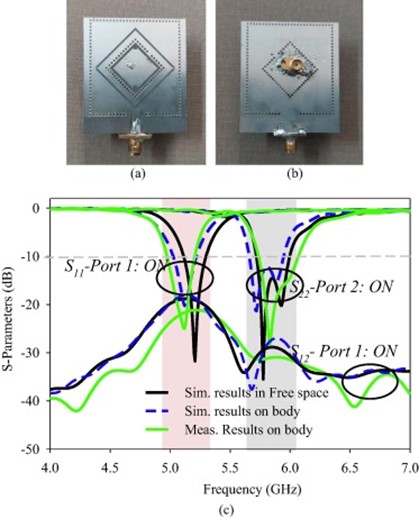
With the recent advancements in modern wireless body area network (WBAN) communication, the demand for compact low-profile wireless computing devices has witnessed a vast increase. Consequently, the antennas which play a critical role in this network are developed with different polarization in distinct frequency bands so as to maintain better reliability of communication links. Dr Divya Chaturvedi, Assistant Professor, Department of Electronics and Communication Engineering, has published a paper titled, “A Dual-Band Dual-Polarized SIW Cavity-Backed Antenna-Duplexer for Off-body Communication” as first author in the Q1 Journal AEJ – Alexandria Engineering Journal having an impact factor of 6.77. The paper discusses the self-duplexing antennas, offering two channels for concurrent transmission and reception, leading to a simple and compact transceiver.
Abstract
A novel dual-band, dual-polarized antenna-duplexer scheme is intended to be used for WLAN 802.11a and ISM band applications using Substrate Integrated Waveguide (SIW) Technology. The antenna consists of two planar SIW cavities of different dimensions where a smaller sized diamond- shaped cavity is inserted inside the larger rectangular cavity to share the common aperture area. The diamond-ring shaped slots are etched in each cavity for radiation. The larger diamond ring slot is excited with a microstrip feedline to operate at 5.2 GHz while the smaller slot is excited with a coaxial probe to operate at 5.8 GHz. The antenna produces linear polarization at 5.2 GHz (5.1–5.3 GHz) due to the merging of TE 110 and TE 120 cavity modes while circular polarization around 5.8 GHz due to orthogonally excited TM100 and TM010 modes (5.68–5.95 GHz). The slots are excited in an orthogonal fashion to maintain a better decoupling between the ports (i.e. –23 dB). The performance of the antenna has been verified in free space as well as in the vicinity of the human body. The antenna offers the gain of 6.2 dBi /6.6 dBi in free space and 5.8 dBi / 6.4 dBi on-body at lower-/ higher frequency-bands, respectively. Also, the specific absorption rate (SAR) is obtained < 0.245 W/Kg for 0.5 W input power averaged over 10 mW/g mass of the tissue. The proposed design is a low-profile, compact single-layered design, which is a suitable option for off-body communication.
Explanation of the research in layperson’s terms
- This antenna can operate in dual radio frequency bands at 5.2 GHz and 5.8 GHz respectively.
- The antenna can be used in the medical instrument to make it wire-free.
- The antenna is compact in size, thus can be accommodated in a small space.
- The antenna can operate simultaneously at both the frequency bands, thus at the same time it can help in forming links with another on-body antenna and makes the link with Wi-Fi.
- The antenna is validated in terms of Specific absorption rate, hence it is safe to use on the human body.

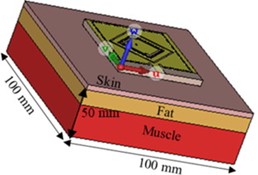
The paper further expounds on the social implication of this innovative research. Dr Chaturvedi explains that the antenna, being dual-band and dual-polarized, can function as a transceiver circuit. Due to different polarization, it can operate in both the frequency bands simultaneously without affecting the performance. In the first frequency band at 5.2 GHz, it can link with Wi-Fi and in the second frequency band at 5.8 GHz, it is able to communicate with antennas placed in other medical instruments which are used in the vicinity of the human body.
Collaborations
1. Dr Arvind Kumar, Assis. Professor, b Department of Electronics and Communication
Engineering, VNIT Nagpur, India2. Dr Ayman A Althuwayb, Department of Electrical Engineering, College of Engineering,
Continue reading →
Jouf University, Sakaka, Aljouf 72388, Saudi Arabia

